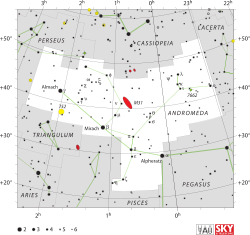Psi Andromedae
| Observation data Epoch J2000 Equinox J2000 |
|
|---|---|
| Constellation | Andromeda |
| Right ascension | 23h 46m 02.04663s |
| Declination | +46° 25′ 12.9788″ |
| Apparent magnitude (V) | 4.95 |
| Characteristics | |
| Spectral type | G5 Ib + B9 |
| U−B color index | +0.83 |
| B−V color index | +1.085 |
| Astrometry | |
| Radial velocity (Rv) | -23.62 km/s |
| Proper motion (μ) |
RA: +9.07 mas/yr Dec.: -7.83 mas/yr |
| Parallax (π) | 3.25 ± 0.47mas |
| Distance | approx. 1,000 ly (approx. 310 pc) |
| Absolute magnitude (MV) | –3.039 |
| Details | |
| ψ And A | |
| Mass | 5.4 M☉ |
| Surface gravity (log g) | 1.50 cgs |
| Temperature | 4,990 K |
| Metallicity [Fe/H] | +0.10 dex |
| Age | 79 Myr |
| Other designations | |
| Database references | |
| SIMBAD | data |
| Database references | |
| SIMBAD | data |
Psi Andromedae (ψ And, ψ Andromedae) is the Bayer designation for a triple star system in the northern constellation of Andromeda. The combined apparent visual magnitude of this system is 4.95. Based upon parallax measurements, is roughly 1,000 light-years (310 parsecs) from Earth, with 14% margin of error.
The primary component has a stellar classification of G5 Ib, which matches the spectrum of an evolved bright giant star. It forms a pair with a star of type B9 with an unknown luminosity class separated by 0.28 arcseconds. A third component has a separation of 0.14 arcseconds. Details of the orbital arrangement remain uncertain.
In Chinese, 螣蛇 (Téng Shé), meaning Flying Serpent, refers to an asterism consisting of ψ Andromedae, α Lacertae, 4 Lacertae, π2 Cygni, π1 Cygni, HD 206267, ε Cephei, β Lacertae, σ Cassiopeiae, ρ Cassiopeiae, τ Cassiopeiae, AR Cassiopeiae, 9 Lacertae, 3 Andromedae, 7 Andromedae, 8 Andromedae, λ Andromedae, κ Andromedae and ι Andromedae,. Consequently, ψ Andromedae itself is known as 螣蛇二十 (Téng Shé èrshí, English: the Twentieth of Flying Serpent).
...
Wikipedia

